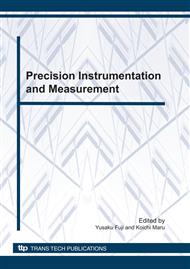[1]
T. Inoue, M. Nakano, T. Kubo and S. Matsumoto: High Accuracy Control Magnet Power Supply of Proton Synchrotron in Recurrent Operation The Trans. of The Institute of Electrical Engineers of Japan Vol. 100 (1980), pp.234-240.
Google Scholar
[2]
T. Inoue, S. Iwai and M. Nakano: High Accuracy Control of Play-Back Servo System The Trans. of The Institute of Electrical Engineers of Japan Vol. 101-4 (1981), pp.89-96.
Google Scholar
[3]
S. Hara, T. Omata and M. Nakano: Stability Condition and Synthesis Methods for Repetitive Control System Trans. of the Society of Instrument and Control Engineers Vol. 22-1 (1986), pp.36-42.
DOI: 10.9746/sicetr1965.22.36
Google Scholar
[4]
Y. Yamamoto and S. Hara: The Internal Model Principle and Stabilizability of Repetitive Control System Trans. of the Society of Instrument and Control Engineers Vol. 23-8 (1987), pp.830-834.
Google Scholar
[5]
S. Hara and Y. Yamamoto: Stability of Multivariable Repetitive Control Systems - Stability Condition and Class of Stabilizing Controllers Trans. of the Society of Instrument and Control Engineers Vol. 22-12 (1986), pp.1256-1261.
DOI: 10.9746/sicetr1965.22.1256
Google Scholar
[6]
S. Hara, Y. Yamamoto, T. Omata and M. Nakano: Repetitive Control System: A New Type Servo System for Periodic Exogenous Signals IEEE Trans. on Automatic Control Vol. AC-33-7 (1988), pp.659-668.
DOI: 10.1109/9.1274
Google Scholar
[7]
T. Omata, S. Hara and M. Nakano: Nonlinear Repetitive Control with Application to Trajectory Control of Manipulators J. of Robotic Systems Vol. 4-5 (1987), pp.631-652.
DOI: 10.1002/rob.4620040505
Google Scholar
[8]
K. Watanabe and M. Yamatari: Stabilization of Repetitive Control System-Spectral Decomposition Approach Trans. of the Society of Instrument and Control Engineers Vol. 22-5 (1986), pp.535-541.
DOI: 10.9746/sicetr1965.22.535
Google Scholar
[9]
M. Ikeda and M. Takano: Repetitive Control for Systems with Nonzero Relative Degree Trans. of the Society of Instrument and Control Engineers Vol. 24-6 (1988), pp.575-582.
DOI: 10.9746/sicetr1965.24.575
Google Scholar
[10]
H. Katoh and Y. Funahashi: A Design Method of Repetitive Controllers Trans. of the Society of Instrument and Control Engineers Vol. 32-12 (1996), pp.1601-1605.
DOI: 10.9746/sicetr1965.32.1601
Google Scholar
[11]
M. Gotou, S. Matsubayashi, F. Miyazaki, S. Kawamura and S. Arimoto: A Robust System with an Iterative Learning Compensator and a Proposal of Multi-Period Learning Compensator J. of The Society of Instrument and Control Engineers Vol. 5 (1987).
Google Scholar
[12]
H. Sugimoto and K. Washida: A Production of Modified Repetitive Control with Corrected Dead Time Trans. of the Society of Instrument and Control Engineers Vol. 34 (1998), pp.645-647.
DOI: 10.9746/sicetr1965.34.645
Google Scholar
[13]
H. Sugimoto and K. Washida: A Design Method for Modified Repetitive Control with Corrected Dead Time Trans. of the Society of Instrument and Control Engineers Vol. 34 (1998), pp.761-768.
DOI: 10.9746/sicetr1965.34.761
Google Scholar
[14]
T. Okuyama, K. Yamada and K. Satoh: A Design Method for Repetitive Control Systems with a Multi-Period Repetitive Compensator Theoretical and Applied Mechanics Japan Vol. 51 (2002), pp.161-167.
Google Scholar
[15]
K. Yamada, K. Satoh and T. Arakawa: A Design Method for Repetitive Control Systems with Multi-Period Repetitive Compensator Trans. Japan Soc. Mechanical Engineers Vol. 69-686 (2003), pp.2691-2699.
DOI: 10.1299/kikaic.69.2691
Google Scholar
[16]
H. L. Broberg and R. G. Molyet: A new approach to phase cancellation in repetitive control Proc. of the 29th IEEE IAS (1994), pp.1766-1770.
DOI: 10.1109/ias.1994.377667
Google Scholar
[17]
M. Steinbuch: Repetitive Control for Systems with Uncertain Period-time Automatica Vol. 38 (2002), pp.2103-2109.
DOI: 10.1016/s0005-1098(02)00134-6
Google Scholar
[18]
D. C. Youla, H. Jabr and J. J. Bongiorno: Modern Wiener-Hopf design of optimal controllers. Part I IEEE Trans. Automatic Control Vol. AC-21 (1976), pp.3-13.
DOI: 10.1109/tac.1976.1101139
Google Scholar
[19]
V. Kucera: Discrete linear system, The polynomial equation approach Wiley (1979).
Google Scholar
[20]
J. J. Glaria and G. C. Goodwin: A parameterization for the class of all stabilizing controllers for linear minimum phase system IEEE Trans. Automatic Control Vol. AC-39 (1994), pp.433-434.
DOI: 10.1109/9.272352
Google Scholar
[21]
M. Vidyasagar: Control System Synthesis - A factorization approach MIT Press (1985).
Google Scholar
[22]
K. Yamada, K. Satoh and T. Arakawa: The Parameterization of all Stabilizing Multi-period Repetitive Controllers Int. Conf. Cybernetics and Information Technologies, System and Applications Vol. Ⅱ (2004), pp.358-363.
Google Scholar
[23]
K. Yamada, K. Satoh and T. Arakawa: A Design Method for Multi-period Repetitive Controllers (Design Method Using the Parameterization of all Multi-period Repetitive Controllers) Trans. Japan Soc. Mechanical Engineers Vol. 71-710C (2005).
DOI: 10.1299/kikaic.71.2945
Google Scholar
[24]
K. Yamada and H. Takenaga: A design method of simple multi-period repetitive controllers International Journal of Innovative Computing, Information and Control Vol. 4-12 (2008), pp.3231-3245.
DOI: 10.1109/icicic.2008.22
Google Scholar


